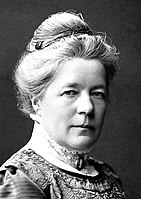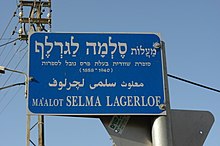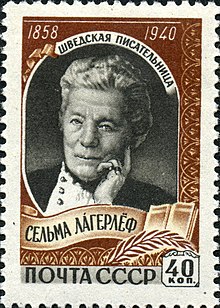
Overview
Selma Ottilia Lovisa Lagerlf (Swedish: (![]() listen); 20 November 1858 – 16 March 1940) was a Swedish author and teacher. She was the first female writer to win the Nobel Prize in Literature.
listen); 20 November 1858 – 16 March 1940) was a Swedish author and teacher. She was the first female writer to win the Nobel Prize in Literature.
Early life
Born at Mrbacka (now in Sunne Municipality) an estate in Vrmland in western Sweden, Lagerlf was the daughter of Lieutenant Erik Gustaf Lagerlf and Louise Lagerlf ne Wallroth, the couple’s fifth child out of six. She was born with a hip injury. An early sickness left her lame in both legs, although she later recovered. She was a quiet child, more serious than others her age, with a deep love for reading. She was constantly writing poetry as a child, but did not publish anything officially until later in life. Her grandmother helped raise her, often telling stories of fairytales and fantasy. The sale of Mrbacka following her father’s illness in 1884 had a serious impact on her development. Selma’s father is said to have been an alcoholic, something she rarely discussed. Her father did not want Selma to continue an education, or remain involved with the woman’s movement. She ended up buying back her father’s estate with the money she received for her Nobel Prize achievement.
Career
Lagerlf was educated at the Hgre lrarinneseminariet in Stockholm from 1882 to 1885. She worked as a country schoolteacher at a high school for girls in Landskrona from 1885 to 1895 while honing her story-telling skills, with particular focus on the legends she had learned as a child. Through her studies at the Royal Women’s Superior Training Academy in Stockholm, Lagerlf reacted against the realism of contemporary Swedish language writers such as August Strindberg. She began her first novel, Gsta Berling’s Saga, while working as a teacher in Landskrona. Her first break as a writer came when she submitted the first chapters to a literary contest, and won a publishing contract for the whole book. At first, her writing only received mild reviews from critics. Once a popular male critic, George Brandes, gave her positive reviews of the Danish translation, her popularity soared. She received financial support of Fredrika Limnell, who wished to enable her to concentrate on her writing.
In 1894 she met the Swedish writer Sophie Elkan, who became her friend and companion; their letters suggest Lagerlf fell deeply in love with her. Over many years, Elkan and Lagerlf critiqued each other’s work. Lagerlf wrote that Elkan strongly influenced her work and that she often disagreed sharply with the direction Lagerlf wanted to take in her books. Selma’s letters to Sophie were published in 1993, titled Du lr mig att bli fri (You Teach me to be Free).
Selma Lagerlf receives the Nobel Prize in Literature. Illustration from Svenska Dagbladet, 11 December 1909.
A visit in 1900 to the American Colony in Jerusalem became the inspiration for Lagerlf’s book by that name. The royal family and the Swedish Academy gave her substantial financial support to continue her passion By 1895, she gave up her teaching to devote herself to her writing. With the help of proceeds from Gsta Berlings Saga and a scholarship and grant, she made two journals which were largely instrumental in providing material for her next novel. With Elkan, she traveled to Italy, and she also traveled to Palestine and other parts of the East. In Italy, a legend of a Christ Child figure that had been replaced with a false version inspired Lagerlf’s novel Antikrists mirakler (The Miracles of the Antichrist). Set in Sicily, the novel explores the interplay between Christian and socialist moral systems. However, most of Lagerlf’s stories were set in Vrmland.
In 1902, Lagerlf was asked by the National Teacher’s Association to write a geography book for children. She wrote Nils Holgerssons underbara resa genom Sverige (The Wonderful Adventures of Nils), a novel about a boy from the southernmost part of Sweden, who had been shrunk to the size of a thumb and who travelled on the back of a goose across the country. Lagerlf mixed historical and geographical facts about the provinces of Sweden with the tale of the boy’s adventures until he managed to return home and was restored to his normal size. The novel is one of Lagerlf’s most well-known books, and it has been translated into more than 30 languages.
She moved in 1897 to Falun, and met Valborg Olander, who became her literary assistant and friend, but Elkan’s jealousy of Olander was a complication in the relationship. Olander, a teacher, was also active in the growing women’s suffrage movement in Sweden. Selma Lagerlf herself was active as a speaker for the National Association for Women’s Suffrage, which was beneficial for the organisation because of the great respect which surrounded Lagerlf, and she spoke at the International Suffrage Congress in Stockholm in June 1911, where she gave the opening address, as well as at the victory party of the Swedish suffrage movement after women suffrage had been granted in May 1919.
Selma Lagerlf was a friend of the German-Jewish writer Nelly Sachs. Shortly before her death in 1940, Lagerlf intervened with the Swedish royal family to secure the release of Sachs and Sachs’ aged mother from Nazi Germany, on the very last flight from Germany to Sweden, and their lifelong asylum in Stockholm.
Literary adaptations
A street in Jerusalem, named for Lagerlf
In 1919 Lagerlf sold all the movie rights to all of her as-yet unpublished works to Swedish Cinema Theatre (Swedish: Svenska Biografteatern), and so over the years many movie versions of her works were made. During the era of Swedish silent cinema her works were used in film by Victor Sjstrm, Mauritz Stiller and other Swedish film makers. Sjstrm’s retelling of Lagerlf’s tales about rural Swedish life, in which his camera recorded the detail of traditional village life and the Swedish landscape, provided the basis of some of the most poetic and memorable products of silent cinema. Jerusalem was adapted in 1996 into an internationally acclaimed film Jerusalem.
Awards and commemoration
Selma Lagerlf on a 1959 postage stamp of the Soviet Union.
On 10 December 1909, Selma Lagerlf won the Nobel Prize “in appreciation of the lofty idealism, vivid imagination and spiritual perception that characterize her writings”. But the decision was preceded by harsh internal power struggle within the Swedish Academy, the body that awards the Nobel Prize in literature. During her acceptance speech, she remained humble and told a fantastic story of her father, as she visited him in heaven. In the story, she asks her father for help with the debt she owes and her father explains the debt is from all the people that supported her throughout her career. In 1904, the Academy had awarded her its great gold medal, and in 1914 she also became a member of the Academy. For both the Academy membership and her Nobel literature prize, she was the first woman to be so honored. In 1991 she became the first woman to be depicted on a Swedish banknote, when the first 20 kronor note was released.
In 1907 she received the degree of doctor of letters from Uppsala University. In 1928, she received an honorary doctorate from the University of Greifswald‘s Faculty of Arts. At the start of World War II, she sent her Nobel Prize medal and gold medal from the Swedish Academy to the government of Finland to help raise money to fight the Soviet Union. The Finnish government was so touched that it raised the necessary money by other means and returned her medal to her.
Two hotels are named after her in stra mtervik in Sunne, and her home, Mrbacka, is preserved as a museum.
One of her stories, The Rattrap, was included as a part of the Indian Curriculum, for high school students.




